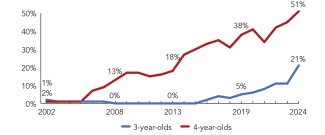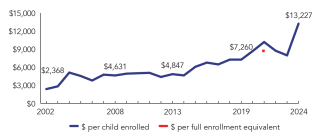
State of Preschool
New Mexico
Access Rankings
Resource Rankings
Total Benchmarks Met
Overview

During the 2023-2024 school year, New Mexico PreK programs enrolled 16,095 children, an increase of 2,868 from the prior year. State spending totaled $212,888,058, up $107,488,625 (102%), adjusted for inflation, from the prior year. State spending per child equaled $13,227 in 2023-2024, up $5,258 from 2022-2023, adjusted for inflation. New Mexico met 9 of 10 quality standards benchmarks.
What's New

During the 2023 New Mexico legislative session, nearly $100 million from the Land Grant Permanent Fund was appropriated to the Early Childhood Education and Care Department (ECECD) to award a total of 279 NM PreK grants to 84 school district programs and 195 community-based programs, family child care providers, Tribal governments (funding 554 new Tribal PreK slots), and Head Start grantees. This was the largest expansion of NM PreK ever. The funding was also used to significantly expand instructional hours, including an extended plus option, and increased the wages of NM PreK teachers in the awarded programs.
In the 2023-2024 school year, NM PreK programs received a significant increase in the per-child rate to reflect higher salaries for teachers and assistant teachers and an increase in instructional hours. In addition, there were increases for transportation costs and funding for research-based curricula. The state also expanded enrollment of three-year olds in public schools.
Background
NM PreK launched in the 2005-2006 school year with the enactment of the Pre-Kindergarten Act. With the passage of the Early Childhood Education and Care Department Act in 2019, the program is now administered by ECECD, which funds and monitors NM PreK programs in both school-and community based settings. In the 2023-2024 school year, 94% of school districts offered NM PreK.
NM PreK funding is awarded through a competitive grant process, with priority given to programs in communities with public elementary schools designated as Title I. Two-thirds of enrolled children at each program site must live in the attendance zone of a Title I elementary school, though eligibility is not determined by family income.
The number of hours and days per week varies by program, with a minimum of 540 hours per year. In 2023-2024, the minimum hours for full-day NM PreK increased from 900 to 1,080 and the extended-plus program option provided a minimum of 1,380 hours over the full calendar year. In 2023-2024, nearly 96% of all children enrolled were in a full-day Pre-K program. Some families access child care assistance funding to support for wraparound care.
New Mexico PreK
Access
Resources
| Total state pre-K spending | $212,888,058 |
| Local match required? | No |
| State Head Start spending | $5,419,268 |
| State spending per child enrolled | $13,227 |
| All reported spending per child enrolled* | $13,227 |

*Pre-K programs may receive additional funds from federal or local sources that are not included in this figure. †Head Start per-child spending includes funding only for 3- and 4-year-olds. ‡K–12 expenditures include capital spending as well as current operating expenditures.
New Mexico Quality Standards Checklist
| Policy | Requirement | Benchmark | Meets Benchmark? |
|---|---|---|---|
For more information about the benchmarks, see the Executive Summary and the Roadmap to State pages. | 9benchmarks met | ||
| Early Learning & Development Standards Benchmark | Comprehensive, aligned, supported, culturally sensitive | Comprehensive, aligned, supported, culturally sensitive | |
| Curriculum Supports Benchmark | Approval process & supports | Approval process & supports | |
| Teacher Degree Benchmark | BA (public); Working toward BA (nonpublic) | BA | |
| Teacher Specialized Training Benchmark | ECE, CD, ECE SpEd (public); ECE, CD (nonpublic) | Specializing in pre-K | |
| Assistant Teacher Degree Benchmark | AA in ECE | CDA or equivalent | |
| Staff Professional Development Benchmark | 24 hours/year; PD plans; Coaching | For teachers & assistants: At least 15 hours/year; individual PD plans; coaching | |
| Maximum Class Size Benchmark | 16 (3-year-olds); 20 (4-year-olds) | 20 or lower | |
| Staff to Child Ratio Benchmark | 1:8 (3-year-olds); 1:10 (4-year-olds) | 1:10 or better | |
| Screening & Referral Benchmark | Vision, hearing, health & more | Vision, hearing & health screenings; & referral | |
| Continuous Quality Improvement System Benchmark | Structured classroom observations; Data used for program improvement | Structured classroom observations; data used for program improvement | |
